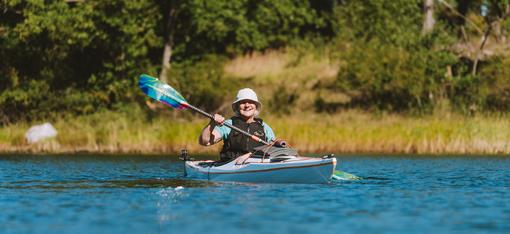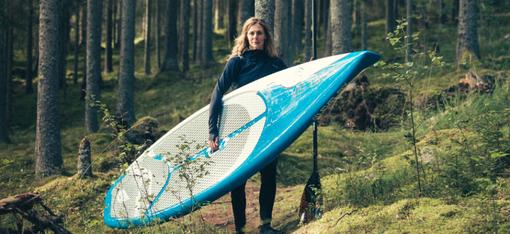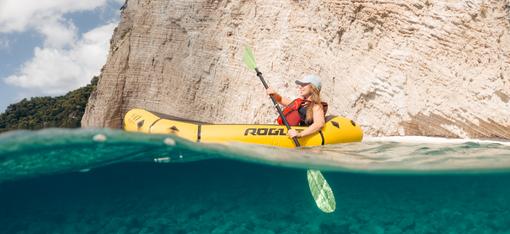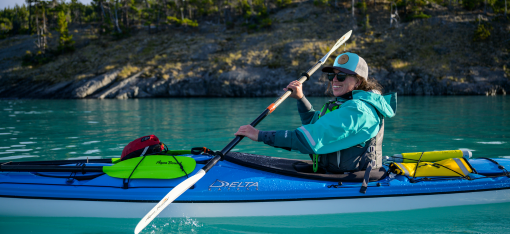All You Need to Know to Paddle on Lakes
7-minute read + 18-minute video
Lakes are wonderful places to paddle. Because they don’t have current, they’re also great waterways for beginners to learn paddling skills.

(Photo: Avery Rosenthal-Murray)
As Aqua Bound Ambassador, Ken Whiting, points out in the video below, though, there are also some things you need to know so your paddling is as safe as possible.
Just a note: Ken focuses on kayaking in this video, but these general guidelines hold true for paddling any type of boat: kayak, canoe, paddle board or packraft.
So watch the video below, then we’ll summarize Ken’s instruction and provide some additional commentary:
Always Wear a PFD
“Your PFD should be looked at just like your seat belt in your vehicle,” says Ken. “You never know what can happen, and a lot of times, what happens is not in your control…Like your seat belt, you put it on for that one time in a thousand that it can change your life.”
In the above video, Ken describes the difference between a PFD (Personal Flotation Device) and a life jacket, even though most of us use those terms interchangeably.
Unlike a true life jacket that’s designed to hold an unconscious person’s head above water, a PFD is intended as a swimming aid in the event of a capsize while you paddle. It helps you swim much further and longer—and in rougher conditions—than you could without it.
PFDs designed for paddling are comfortable and offer plenty of room for shoulder movement so you don’t feel restricted while you paddle.
Stick Close to Shore
While capsizing is rare, it does happen, especially when wind and waves are involved. Any boat can capsize given the right conditions.
If you’re confident in your self-rescue skills and have practiced them over and over again (even in rough water), it isn’t as necessary to stick close to shore. But there are several scenarios when keeping the shore nearby is required versus paddling in the middle of a large lake:
- You’re in a kayak and don’t have a reliable roll—or are paddling a kayak that isn’t capable of rolling back upright.
You’re not able to self-rescue in your kayak, packraft, paddle board or canoe.
- You’re paddling on water cold enough to cause hypothermia, making it dangerous to stay in the water for more than a few minutes because you’re not wearing the proper protective gear.
- You’re paddling alone.
- You’ve brought young children with you, which makes it much harder to recover from a capsize and swim to shore.
- You’re paddling an inflatable boat, capsize, and find the wind carries your lightweight inflatable faster down the lake than you can swim.

(Photo courtesy of Kate Wright)
We highly recommend taking paddling courses with instructors who are certified by your country’s paddling association (like the ACA, American Canoe Association, here in the US). Safety and self-rescue are covered in these courses, with the opportunity to practice these skills.
Paddle the Right Kind of Boat
“If you’re going to travel further from shore than you can comfortably swim or paddle on lakes that are big enough so that if the wind really picks up, they can get significant waves, then you need to use a kayak that has some type of flotation,” Ken says.
He goes over three types of flotation:
Inherent flotation means the boat will float, even if capsized. These include sit-on-top and inflatable kayaks, almost any type of canoe, paddle boards (whether solid or inflatable) and packrafts.
Since inflatables can also tend to get blown around by wind (especially ultralight packrafts), it’s a good idea to tether them to you somehow (i.e., like the leash on a SUP).

(Photo: Florian Guillier)
Bulkheads are walled-off compartments in higher-end kayaks that hold air in, even if the kayak is upside down in the water. Bulkheads keep the kayak sitting higher on the water. A kayak with bulkheads is much easier to re-enter from the water or drag while you swim back to shore.
Flotation bags are necessary if the boat you’re paddling doesn’t have bulkheads or won’t float well. These are inflatable bags that fit into the bow and stern and provide extra flotation in case your boat swamps.
Another thing to consider if you want to paddle away from shore and/or on very big lakes—big enough that waves will be significant—is using a kayak or packraft that can accommodate a skirt. A skirt will prevent water from getting inside.
The Single Biggest Hazard of Lake Paddling
The single biggest challenge or hazard you’ll face while paddling on lakes is wind.
Wind affects you in a few ways. First, it affects your paddling speed. A strong headwind will slow you down. A good tailwind will speed you up. Wind coming at you from the side will push your boat to the side. A side wind can even cause a capsize if it’s pushing up big waves.
Another effect of a side wind—especially in long boats like touring and sea kayaks—is that it can cause something called weathercocking. This is when the bow of your kayak wants to face into the wind, even when you’re attempting to paddle sideways from the wind.
A kayak with a skeg or rudder holds the back of your kayak more securely and helps prevent weathercocking.
As a general rule, Ken suggests staying off the lake if the wind is 15 mph or more. And really, even winds that strong are best with a touring or sea kayak that’s designed to handle wind and waves. Canoes, packrafts and paddle boards are much more fun to paddle when it’s not windy.

(Photo: Avery Rosenthal-Murray)
Finally, wind is the cause of waves on lakes. Before you get out on the water, you’ll need to know the wind speed and direction. Those will determine the waves on the lake you want to paddle.
Small lakes only get small waves because the wind doesn’t have enough room to blow up big ones. But on big lakes, strong winds can produce big waves, especially if the wind is coming from a direction that gives it ample space.
Paddling any kind of boat in large waves requires training, practice and skill to do it safely. If your goal is to get out on very big lakes, we encourage you to take courses that will give you those skills.
Certified instructors will teach you to relax, keep your weight centered, and learn about wave direction and size, and how to deal with them. And they’ll teach you when it’s safest to simply stay off the water.
Other Lake Hazards
Thunderstorms and lightning are never a safe combo when paddling. And the myth that lightning only strikes if the thunder is close by is just that—a myth.
If you can hear thunder, lightning can strike anywhere near you, even if the thunder is 10 miles away. Wait out the storm and then get back on the water when the weather has cleared.
Power boat traffic can be another real hazard when you’re paddling. Most power boaters aren’t looking for paddlers, and you don’t want to be hit by one. If you do paddle in waters with boat traffic:
- Be highly visible with your boat, paddle, PFD or apparel. Be easy to see on the water.
- Be aware of the power boats around you and stay out of their way. Faster boats get the right of way.
- Avoid lakes with a lot of power boat traffic or paddle during days and times when these boaters aren’t active.
\If you’re on very big water with large power boats (like the Great Lakes), have everyone in your group stay close together. You’ll be easier to see than if you’re spread out over the water.

(Photo: Ken Whiting and @Go Paddle)
Lakes are wonderful places to paddle, but you want to be aware of the risks and gain the skills you’ll need to paddle them safely!
Watch more instructional paddling videos by Ken Whiting on the Paddle TV YouTube channel.
What paddling questions can our friendly Customer Service team help you with? Contact us at 715-755-3405 or sales@aquabound.com, or choose our online chat option.
More for you...





